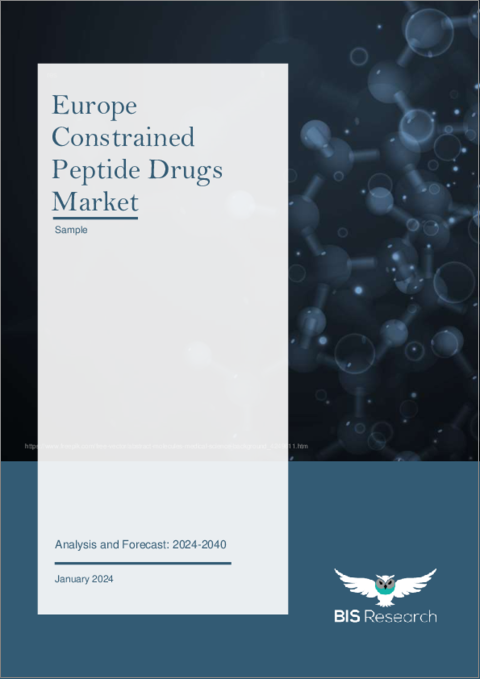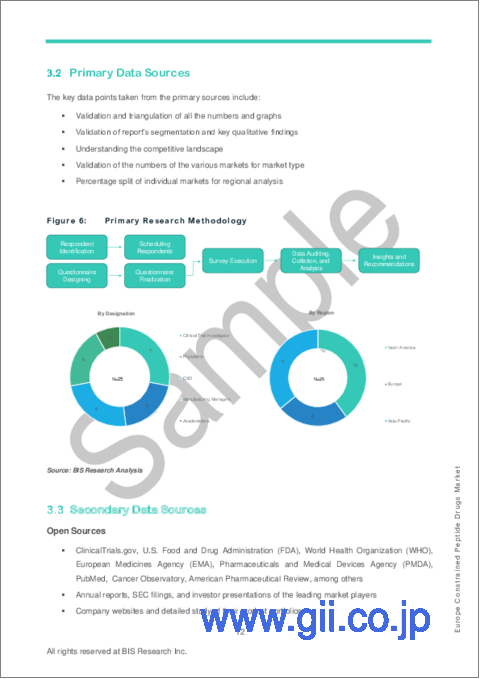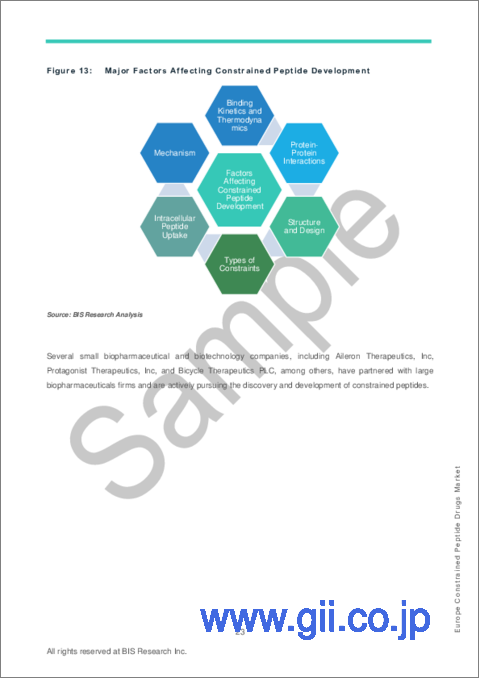|
|
市場調査レポート
商品コード
1419009
欧州の拘束性ペプチド薬市場 - 分析と予測(2024年~2040年)Europe Constrained Peptide Drugs Market: Analysis and Forecast, 2024-2040 |
||||||
カスタマイズ可能
|
|||||||
| 欧州の拘束性ペプチド薬市場 - 分析と予測(2024年~2040年) |
|
出版日: 2024年01月31日
発行: BIS Research
ページ情報: 英文 84 Pages
納期: 1~5営業日
|
全表示
- 概要
- 図表
- 目次
| 主要市場統計 | |
|---|---|
| 予測期間 | 2026年~2040年 |
| 2026年の評価 | 6,000万米ドル |
| 2040年予測 | 77億2,000万米ドル |
| CAGR | 41.55% |
欧州の拘束性ペプチド薬の市場規模は2026年に6,000万米ドル、2040年には77億2,000万米ドルに達すると予測され、予測期間の2026年~2040年のCAGRは41.55%になると見込まれています。
拘束性ペプチド薬市場は、今や単なる受容体以上のものを標的とする革新的な拘束性ペプチドパイプラインに牽引され、大きな成長が見込まれます。化学技術の進歩、治療における合成ペプチドの成功、さまざまな疾患における手頃な価格も、予測期間における予測成長に寄与しています。
欧州の拘束性ペプチド薬市場は、今後数年間で大きく成長する見込みです。この市場拡大の主な原動力のひとつは、研究開発、イノベーション、強力な規制枠組みを特徴とする、この地域の強固な製薬産業です。欧州の製薬会社は、ペプチド化学の最先端技術と専門知識を活用し、拘束性ペプチド薬の開発で最先端を走ってきました。
さらに、欧州では、特にがん、自己免疫疾患、代謝性疾患などの様々な疾患の治療において、新規の治療アプローチに対する需要が高まっています。拘束性ペプチドは、その特異性、有効性と安全性を高める可能性から、有望な解決策を提供します。
さらに、欧州では、学会、研究機関、製薬企業間の共同努力が、拘束性ペプチドをベースとした治療薬の発見と開発を加速させています。このような協力的なエコシステムはイノベーションを促進し、欧州を拘束性ペプチド薬市場における重要な参入市場として位置づけています。
当レポートでは、欧州の拘束性ペプチド薬市場について調査し、市場の概要とともに、国別、企業別の動向、および市場に参入する企業のプロファイルなどを提供しています。
目次
エグゼクティブサマリー
第1章 定義
第2章 調査範囲
第3章 調査手法
第4章 市場の概要
- イントロダクション
- 拘束性ペプチドの構造と設計
- 拘束性ペプチドの種類
- 抑制要因されたペプチドの進化
- 薬剤としての拘束性ペプチドの開発
- 潜在的な治療領域
- バリューチェーン-主要な利害関係者
- 主要な業界動向(地域別)
- 行政経路別の主要な業界動向
- 主要な業界動向- 技術の進歩
- 現在の市場規模と成長の可能性、10億米ドル、2024年~2040年
- COVID-19が拘束性ペプチド薬市場に与える影響
- 拘束性ペプチド薬企業への影響
- 臨床試験の中断と再開
第5章 欧州
- 拘束性ペプチド薬市場(国別)、10億米ドル、2024年~2031年
- 欧州
第6章 企業プロファイル
- Bicycle Therapeutics plc
- Spexis AG
- Santhera Pharmaceuticals
- Union Chimique Belge S.A.(UCB)
- Biosynth(Pepscan)
List of Figures
- Figure 1: Europe Total Number of Drugs Approved by the U.S. FDA, 2016-2021
- Figure 2: Europe Constrained Peptide Drugs Market, $Billion, 2024-2031
- Figure 3: Europe Constrained Peptide Drugs Market, $Billion, 2032-2040
- Figure 4: Europe Constrained Peptide Drugs: Impact Analysis
- Figure 5: Constrained Peptide Drugs Market (by Region), $Billion, 2024-2040
- Figure 6: Constrained Peptide Drugs Methodology
- Figure 7: Primary Research Methodology
- Figure 8: Epidemiology-Based Approach
- Figure 9: Inducing Conformational Effects
- Figure 10: Two Main Types of Constraints
- Figure 11: Methodology for Restricting Conformation in Peptides
- Figure 12: Types of Constrained Peptides
- Figure 13: Key Milestones in the Evolution of Constrained Peptides
- Figure 14: Major Factors Affecting Constrained Peptide Development
- Figure 15: Value Chain Analysis- Key Stakeholders
- Figure 16: Constrained Peptide Drugs Market (by Region), $Billion, 2024-2031
- Figure 17: Constrained Peptide Drugs Market (by Region), $Billion, 2032-2040
- Figure 18: Europe Constrained Peptide Drugs Market, $Billion, 2024-2031
- Figure 19: Europe Constrained Peptide Drugs Market, $Billion, 2032-2040
- Figure 20: Constrained Peptide Drugs Market (by Region)
- Figure 21: Constrained Peptide Drugs Market (by Region), $Billion, 2024-2040
- Figure 22: Europe Constrained Peptide Drugs Market, $Billion, 2024-2031
- Figure 23: Europe Constrained Peptide Drugs Market, $Billion, 2032-2040
- Figure 24: Europe: Market Dynamics
- Figure 25: Europe Constrained Peptide Drugs Market (by Country), $Billion, 2025 and 2040
- Figure 26: U.K. Constrained Peptide Drugs Market, $Billion, 2024-2031
- Figure 27: U.K. Constrained Peptide Drugs Market, $Billion, 2032-2040
- Figure 28: Germany Constrained Peptide Drugs Market, $Billion, 2024-2031
- Figure 29: Germany Constrained Peptide Drugs Market, $Billion, 2032-2040
- Figure 30: France Constrained Peptide Drugs Market, $Billion, 2024-2031
- Figure 31: France Constrained Peptide Drugs Market, $Billion, 2032-2040
- Figure 32: Italy Constrained Peptide Drugs Market, $Billion, 2024-2031
- Figure 33: Italy Constrained Peptide Drugs Market, $Billion, 2032-2040
- Figure 34: Spain Constrained Peptide Drugs Market, $Billion, 2024-2031
- Figure 35: Spain Constrained Peptide Drugs Market, $Billion, 2032-2040
- Figure 36: Total Number of Companies Profiled
- Figure 37: Bicycle Therapeutics plc: Product Portfolio
- Figure 38: Bicycle Therapeutics plc: Overall Financials, $Million, 2019-2021
- Figure 39: Bicycle Therapeutics plc: Revenue (by Region), $Million, 2019-2021
- Figure 40: Bicycle Therapeutics plc: R&D Expenditure, $Million, 2019-2021
- Figure 41: Spexis AG: Product Portfolio
- Figure 42: Spexis AG: Overall Financials, $Million, 2019-2021
- Figure 43: Spexis AG: R&D Expenditure, $Million, 2019-2021
- Figure 44: Santhera Pharmaceuticals: Product Portfolio
- Figure 45: Santhera Pharmaceuticals: Overall Financials, $Million, 2019-2021
- Figure 46: Union Chimique Belge S.A. (UCB): Product Portfolio
- Figure 47: Union Chimique Belge S.A. (UCB): Overall Financials, $Million, 2019-2021
- Figure 48: Union Chimique Belge S.A. (UCB): R&D Expenditure, $Million, 2019-2021
- Figure 49: Biosynth (Pepscan): Product Portfolio
List of Tables
- Table 1: Potential Indications of Constrained Peptide Drugs
- Table 2: Potential Therapy Areas of Constrained Peptide Drugs
- Table 3: Route of Administration of Constrained Peptide Drugs
- Table 4: Impact of COVID-19 on Constrained Peptide Drug Companies
“The Europe Constrained Peptide Drugs Market Expected to Reach $7.72 Billion by 2040.”
Introduction to Europe constrained peptide drugs market
| KEY MARKET STATISTICS | |
|---|---|
| Forecast Period | 2026 - 2040 |
| 2026 Evaluation | $0.06 Billion |
| 2040 Forecast | $7.72 Billion |
| CAGR | 41.55% |
The market size is anticipated to be $0.06 billion in 2026 and is expected to reach $7.72 billion by 2040, growing at a CAGR of 41.55% during the forecast period 2026-2040. The constrained peptide drugs market is expected to experience significant growth, driven by innovative constrained peptide pipelines that now target more than just receptors. Advances in chemical technologies, the success of synthetic peptides in therapeutics, and their affordability across various diseases are also contributing to the projected growth in the forecast period.
Market Introduction
The Europe constrained peptide drugs market is poised for substantial growth in the coming years. One of the key drivers of this expansion is the region's robust pharmaceutical industry, characterized by a focus on research and development, innovation, and a strong regulatory framework. European pharmaceutical companies have been at the forefront of developing constrained peptide drugs, leveraging cutting-edge technologies and expertise in peptide chemistry.
Additionally, Europe has witnessed a growing demand for novel therapeutic approaches, particularly in the treatment of various diseases such as cancer, autoimmune disorders, and metabolic conditions. Constrained peptides offer a promising solution due to their specificity and potential for enhanced efficacy and safety profiles.
Furthermore, collaborative efforts between academia, research institutions, and pharmaceutical companies in Europe have accelerated the discovery and development of constrained peptide-based therapeutics. This collaborative ecosystem fosters innovation and positions Europe as a significant player in the constrained peptide drugs market.
Market Segmentation
Segmentation 1: by Country
- Germany
- U.K.
- France
- Italy
- Spain
Segmentation 2: by Company
- Bicycle Therapeutics plc
- Spexis AG
- Santhera Pharmaceuticals
- Union Chimique Belge S.A. (UCB)
- Biosynth (Pepscan)
- Zealand Pharma
How can this report add value to an organization?
Workflow/Innovation Strategy: Over the past decade, peptide drug discovery and development has witnessed a renaissance and scientific thrust as the industry has come to acknowledge the capability of peptide therapeutics in addressing unmet medical needs and the potential of this class of molecules to become a significant accompaniment or even favored alternative treatment to biologics and small molecules.
Peptide therapeutics have demonstrated a novel and selective yet safe mode of action for a wide range of indications. The existing and future development of constrained peptide drugs will continue to burgeon upon the strengths of constrained peptides and innovative technologies employed in the discovery and development, including peptide drug conjugates, multifunctional peptides, and cell-penetrating peptides. Furthermore, limitations associated with presently available peptides have resulted in an urgent need for new design, administration, and synthesis in peptide therapeutics, thereby leading to advancements in the development of constrained peptides.
Growth/Marketing Strategy: Constrained peptides provide noteworthy advantages over linear peptides. An increase in interest in constrained peptides due to their properties led to advancements in peptide synthesis technologies.
Competitive Strategy: Key players in the Europe constrained peptide drugs market have been analyzed and profiled in the study, including manufacturers involved in new product development, acquisitions, expansions, and strategic collaborations. Moreover, a detailed competitive benchmarking of the players operating in the Europe constrained peptide drugs market has been done to help the reader understand how players stack against each other, presenting a clear market landscape. Additionally, comprehensive competitive strategies such as partnerships, agreements, and collaborations will aid the reader in understanding the untapped revenue pockets in the market.
Table of Contents
Executive Summary
1. Definition
- 1.1. Inclusion and Exclusion Criteria
2. Research Scope
- 2.1. Key Questions Answered in the Report
3. Research Methodology
- 3.1. Constrained Peptides: Research Methodology
- 3.2. Primary Data Sources
- 3.3. Secondary Data Sources
- 3.4. Market Estimation Model
- 3.5. Criteria for Company Profiling
4. Markets Overview
- 4.1. Introduction
- 4.1.1. Structure and Design of Constrained Peptides
- 4.1.2. Types of Constrained Peptides
- 4.2. Evolution of Constrained Peptides
- 4.3. Development of Constrained Peptides as Drugs
- 4.4. Potential Therapy Areas
- 4.5. Value Chain-Key Stakeholders
- 4.6. Key Industry Trends (by Region)
- 4.7. Key Industry Trends by Route of Administration
- 4.8. Key Industry Trends-Technological Advancements
- 4.9. Current Market Size and Growth Potential, $Billion, 2024-2040
- 4.1. COVID-19 Impact on Constrained Peptides Drugs Market
- 4.10.1. Impact on Constrained Peptide Drugs Companies
- 4.10.2. Clinical Trial Disruptions and Resumptions
5. Europe
- 5.1. Constrained Peptide Drugs Market (by Country), $Billion, 2024-2031
- 5.1.1. Europe
- 5.1.1.1. U.K.
- 5.1.1.2. Germany
- 5.1.1.3. France
- 5.1.1.4. Italy
- 5.1.1.5. Spain
- 5.1.1. Europe
6. Company Profiles
- 6.1. Overview
- 6.2. Bicycle Therapeutics plc
- 6.2.1. Company Overview
- 6.2.2. Role of Bicycle Therapeutics plc in the Constrained Peptide Drugs Market
- 6.2.1. Current Status and Policies for Investigational Drugs
- 6.2.2. Key Competitors of the Company
- 6.2.3. Financials
- 6.2.4. Key Insights about the Financial Health of the Company
- 6.2.5. Corporate Strategies
- 6.2.5.1. Synergistic Activities
- 6.2.5.2. Funding
- 6.2.6. Business Strategies
- 6.2.6.1. Clinical Developments
- 6.2.6.2. Regulatory and Legal
- 6.2.7. Analyst Perspective
- 6.3. Spexis AG
- 6.3.1. Company Overview
- 6.3.2. Role of Spexis AG in the Constrained Peptide Drugs Market
- 6.3.3. Current Status and Policies for Investigational Drugs
- 6.3.4. Key Competitors of the Company
- 6.3.5. Financials
- 6.3.6. Key Insights about the Financial Health of the Company
- 6.3.7. Corporate Strategies
- 6.3.7.1. Funding
- 6.3.7.2. Mergers and Acquisitions
- 6.3.7.3. Synergistic activities
- 6.3.8. Business Strategies
- 6.3.8.1. Regulatory and Legal
- 6.3.9. Analyst Perspective
- 6.4. Santhera Pharmaceuticals
- 6.4.1. Company Overview
- 6.4.2. Role of Santhera Pharmaceuticals in the Constrained Peptide Drugs Market
- 6.4.3. Current Status and Policies for Investigational Drugs
- 6.4.4. Key Competitors of the Company
- 6.4.5. Financials
- 6.4.6. Corporate Strategies
- 6.4.6.1. Funding
- 6.4.7. Business Strategies
- 6.4.7.1. Clinical Developments
- 6.4.8. Analyst Perspective
- 6.5. Union Chimique Belge S.A. (UCB)
- 6.5.1. Company Overview
- 6.5.2. Role of Union Chimique Belge S.A. (UCB) in the Constrained Peptide Drugs Market
- 6.5.3. Current Status and Policies for Investigational Drugs
- 6.5.4. Key Competitors of the Company
- 6.5.5. Financials
- 6.5.6. Key Insights about the Financial Health of the Company
- 6.5.7. Corporate Strategies
- 6.5.7.1. Mergers and Acquisitions
- 6.5.8. Business Strategies
- 6.5.8.1. Clinical Developments
- 6.5.8.2. Regulatory and legal
- 6.5.9. Analyst Perspective
- 6.6. Biosynth (Pepscan)
- 6.6.1. Company Overview
- 6.6.2. Role of Biosynth (Pepscan) in the Constrained Peptide Drugs Market
- 6.6.3. Key Competitors of the Company
- 6.6.4. Corporate Strategies
- 6.6.4.1. License
- 6.6.5. Business Strategies
- 6.6.5.1. Product Launch
- 6.6.6. Analyst Perspective
- 6.6.7. Zealand Pharma
- 6.6.7.1. ZP10000 (Preclinical)
- 6.6.7.1.1. Product Profile
- 6.6.7.1. ZP10000 (Preclinical)





